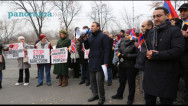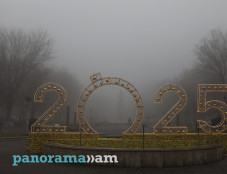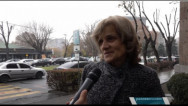
Hayk Demoyan: Aghdam events could, just like attempt on Heydar Aliyev’s life, be planned by Turkish secret services
Over the years new data and details about the tragedy that took place on the outskirts of Aghdam in 1992 are coming to light. But the question is, what other force besides the People's Front of Azerbaijan were, in reality, behind the carnage, which actually no one needed. This issue is still unrevealed.
News agency Panorama.am asked the director of the Armenian Genocide Museum-Institute Hayk Demoyan for commentary.
“Let's call a spade a spade. Ankara may be blamed in Khojalu massacre; the Turkish secret service, to be more precise. Turkey was clearly not satisfied with the figure of Azerbaijani President Ayaz Mutalibov as a pro-Russian politician, which sought to ensure Azerbaijan's membership in the CIS. During the first month after the collapse of the Soviet Union, Turkey supported by the West, especially the United States, actively sought to present itself as a visual model of state building. Turkish leaders in the face of the Popular Front of Azerbaijan found decent support in order to strengthen its influence in Azerbaijan. In this regard, publication of Turkish newspaper “Hurriyet” on 17 May 1992, i.e. 2 days after Mutalibov’s re-overthrow, can be considered a sensation. In the magazine one of the senior Turkish Foreign Ministry officials was quoted who in an outburst of joy said about Mutalibov: “Our boys have done it” the English translation of these words was the most interesting. It’s not hard to guess who these boys are,” Hayk Demoyan says.
Asked about the reasons for Turkey's commitment in the commission of such a bloody act, director of the Armenian Genocide Museum-Institute said that apparently in this case Ankara killed not two but even several birds by one shot.
“First of all, after Armenia gained its independence, the Turkish side became concerned about the possible activation of Armenian Diaspora’s movement, as well as about the recognition of the Armenian Genocide by the independent Armenia and the prospective of possible compensation. From this point of view, the representation of the Armenians as people disposed on mass murders, played into Turkey’s hands, which could seek in Aghdam events a good reason for creating a counter image. One could even claim that it could be considered as a strategic task for Ankara.
Second, the pro-Russian Azerbaijani President Mutalibov was not convenient for Turkish authorities, who would prefer to see obviously pro-Turkish-minded leaders from Popular Front instead of him. Abulfaz Elchibey, APF leader, never concealed his sympathy to everything Turkish, and was constantly expressing himself in an aggressive pan-Turkic manner. Such a massacre was a discrediting evidence for any leader. As a result, we can see that this scenario worked. Mutalibov resigned, PFA in face of Elchibey came to power,” Hayk Demoyan notes.
According to the expert, the involvement of the Turkish agents in the operation of correcting the political administration of Azerbaijan has its own traditions which come since 1918, and February-May events that took place in 1992 can be considered the first successful and a well-planned attempt to recreate these traditions.
“Turkish security forces, who twice tried to remove Heydar Aliyev, didn’t approve of some of his actions after he came to power. The first attempt was so bold and open, that in 1995, during a visit to Baku, the Turkish Prime Minister Tansu Chiller personally apologized to the head of Azerbaijan. The second attempt took place a year later, in 1996, and this time the Azerbaijani special services managed to arrest some persons who were directly connected with the intelligence agencies of Turkey. Let’s add also the assassination attempts on presidents of Uzbekistan and Turkmenistan by Turkish intelligence agencies,” Hayk Demoyan says.
Hayk Demoyan notes that there is another interesting fact; on 25 February Iranian Foreign Minister Ali Akbar Velayati was in Baku on mediatory mission. The visit of Velayati was also planned to be held in Stepanakert and negotiations to be held with the official leadership of the NKR. In the morning of February 27 Velayati left for the capital city of Nagorno-Karabakh, but his plane landed in Aghdam. At a time when Khojalu was under the complete control of Armenian forces, Commander of the Defence Emergency headquarters of Shushi Rahim Gaziyev told by telephone that “the fight for Khojaly continues”. Then Gaziyev continued and said that “the decision of ceasefire (for Velayati’s security) in a situation where the Armenian side captured Khojalu was wrong and is unlikely to be kept."
“It is not difficult to guess that this message contains obvious desire to disrupt A. Velayati’s mission by NFA and the Turkish secret services. The growing influence of Iran in Azerbaijan, especially its role as a mediator in the Karabakh problem, was obviously not within the interests of Ankara. By that time some Western leaders openly stated that the South Caucasus and Central Asia is a zone of Turkish influence, the main role of which according to them was combating the spread of Islamic fundamentalism and Iranian influence. But the most important thing, in my opinion, is the desire of the Turkish side to create grounds for accusing Armenians in crimes against humanity by organizing these mass exterminations," Demoyan stated.
On February 26, 1992, during the war in Karabakh, around 200 to 300 people (according to Human Right Watch, and 600 according to the version propagated by Azerbaijan) were killed in unknown circumstances near the city of Aghdam. They have been deliberately withheld by the Azerbaijani authorities in the midst of the military actions. Population of the village of Khojalu, which was one of the firing points shooting at the blockaded Stepanakert (among five others) was kept in the village for months by force and was not evacuated by the authorities of Azerbaijan deliberately, in order to use them as human shields later.
Residents of Khojalu coming out through the humanitarian corridor, that the self-defense forces of NKR had left open, freely passed more than 10 km and reached the Aghdam city controlled by the Azerbaijani troops. Later, not far from the positions of Azerbaijani troops dead bodies of the villagers were found. The exact death toll remains unknown as the official Baku publishes data contradicting each other. Parliamentary Commission investigating the tragic death of the civilians at Aghdam city was dissolved by the order of Heydar Aliyev, the investigative materials are kept secret.
Documentary: “Between hunger and fire. Power at the cost of lives”
Newsfeed
Videos






























